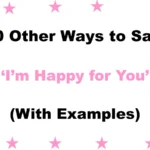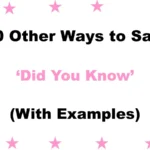In the world of professional communication, clarity and tone are everything. While “point of contact” is a clear and well-understood phrase, using varied terminology can help your message feel more approachable, specific, or even polished—depending on your audience.
Whether you’re introducing someone, assigning roles, or referring a client, having alternatives to “point of contact” can enhance your communication and fit a variety of contexts with more nuance and professionalism.
What Does “Point of Contact” Mean?
A point of contact is the person who serves as the main communicator or coordinator for a specific task, project, department, or organization. This person is usually responsible for answering questions, sharing updates, or relaying information between two parties. In business, the term helps streamline communication and ensure accountability.
When to Use “Point of Contact”
Use “point of contact” when you want to clearly assign or identify the main person responsible for communications related to a task, issue, client, or event. It’s useful in both internal and external communication.
Is It Professional/Polite to Say “Point of Contact”?
Yes. The term is professional and polite. It’s widely used across industries and is especially common in corporate, government, military, and customer service environments. However, depending on your audience, alternatives may sound more conversational, human-centered, or role-specific.
Pros and Cons
Pros:
- Clear and widely understood
- Suitable for formal and official contexts
- Helps establish communication hierarchy
Cons:
- Can sound cold or impersonal
- Overused in corporate jargon
- May not be audience-friendly in casual or customer-facing settings
Synonyms For “Point of Contact”
- Main Contact
- Primary Contact
- Go-To Person
- Assigned Representative
- Liaison
- Client Contact
- Company Contact
- Relationship Manager
- Communications Lead
- Contact Person
- Key Contact
- Lead Coordinator
- Main Representative
- Single Point of Contact (SPOC)
- Support Contact
- Team Lead
- Program Manager
- Business Contact
- Project Contact
- Main Liaison
- Designated Contact
- Admin Contact
- Assigned Contact
- Correspondence Contact
- Operations Contact
- Engagement Manager
- Representative
- Facilitator
- Account Manager
- Coordinator
1. Main Contact
Definition: The primary person for communication.
Detailed Explanation: “Main contact” simplifies the phrase while maintaining clarity.
Scenario Example: “Samantha will be your main contact for this project.”
Best Use: In everyday business emails or project handovers.
Worst Use: In legal or contractual documents requiring more formal terms.
Tone: Clear, casual-professional.
2. Primary Contact
Definition: The person who should be contacted first for any matter.
Detailed Explanation: Similar to “main contact,” but slightly more formal in tone.
Scenario Example: “John is the primary contact for IT-related concerns.”
Best Use: In team rosters, service handovers, or formal settings.
Worst Use: In informal or personal interactions.
Tone: Professional, structured.
3. Go-To Person
Definition: The reliable person for handling specific tasks or information.
Detailed Explanation: More casual and friendly; implies trust and responsibility.
Scenario Example: “Rachel is the go-to person for all client onboarding needs.”
Best Use: In team or internal communications.
Worst Use: In formal reports or external correspondence.
Tone: Informal, approachable.
4. Assigned Representative
Definition: A designated individual representing a department, team, or company.
Detailed Explanation: Suitable for formal or high-stakes communication where representation matters.
Scenario Example: “Your assigned representative will follow up shortly.”
Best Use: In formal documentation, customer service, or government communication.
Worst Use: In casual team chat or email.
Tone: Formal, official.
5. Liaison
Definition: Someone who facilitates communication between groups or organizations.
Detailed Explanation: Common in cross-departmental or cross-company roles.
Scenario Example: “He’ll act as the liaison between legal and compliance.”
Best Use: In interdepartmental or collaborative settings.
Worst Use: In everyday casual internal notes.
Tone: Formal, professional.
6. Client Contact
Definition: The person responsible for communication with a client.
Detailed Explanation: Clearly defines responsibility and the target group (the client).
Scenario Example: “Julie is your dedicated client contact for all account matters.”
Best Use: In B2B communications or client onboarding.
Worst Use: In generic internal memos where no client is involved.
Tone: Clear, customer-centric.
7. Company Contact
Definition: The person who represents the organization in communication.
Detailed Explanation: Neutral term often used in vendor-client relationships.
Scenario Example: “Please direct your questions to our company contact listed below.”
Best Use: For vendor relations or external partnerships.
Worst Use: In internal-only conversations.
Tone: Neutral, formal.
8. Relationship Manager
Definition: A person in charge of managing the relationship between two parties.
Detailed Explanation: Frequently used in finance, sales, or customer success roles.
Scenario Example: “Your relationship manager will coordinate all future interactions.”
Best Use: In high-touch client services or account management.
Worst Use: In casual workplace communication.
Tone: Formal, service-focused.
9. Communications Lead
Definition: The person overseeing communication on a specific topic or project.
Detailed Explanation: Ideal for projects or roles that involve multiple teams.
Scenario Example: “Anna is the communications lead for the product launch.”
Best Use: In project-based teams or collaborative environments.
Worst Use: In one-on-one client relationships.
Tone: Structured, task-oriented.
10. Contact Person
Definition: A general phrase for someone to reach out to.
Detailed Explanation: Very versatile and neutral, suitable across most contexts.
Scenario Example: “The contact person for this event is listed below.”
Best Use: For forms, sign-ups, and general external communication.
Worst Use: Might be vague in highly formal or critical settings.
Tone: Neutral, general.
11. Key Contact
Definition: The most relevant person to reach for specific information or actions.
Detailed Explanation: “Key contact” adds weight and importance to the person’s role, often implying leadership or subject matter expertise.
Scenario Example: “Sarah will be your key contact for marketing initiatives.”
Best Use: When emphasizing someone’s importance in a project or relationship.
Worst Use: In informal or casual contexts—it might sound overly formal.
Tone: Professional, impactful.
12. Lead Coordinator
Definition: The person overseeing and managing tasks and communications.
Detailed Explanation: Often used in events, logistics, or cross-functional roles.
Scenario Example: “Please check with the lead coordinator for scheduling details.”
Best Use: In project management or planning scenarios.
Worst Use: In brief, everyday interactions—it may sound too technical.
Tone: Organized, formal.
13. Main Representative
Definition: The designated person representing a team or organization.
Detailed Explanation: Adds formality while keeping the meaning clear.
Scenario Example: “David will serve as your main representative throughout the transition.”
Best Use: In external communications or introductions.
Worst Use: In one-line emails or fast-paced Slack threads.
Tone: Polite, official.
14. Single Point of Contact (SPOC)
Definition: The only person authorized or designated to handle communications.
Detailed Explanation: A technical or corporate term used to emphasize centralized communication.
Scenario Example: “Please direct all inquiries to your assigned SPOC.”
Best Use: In IT, support, and highly structured teams.
Worst Use: In customer-facing interactions—it may sound too cold.
Tone: Highly formal, structured.
15. Support Contact
Definition: The designated person for assistance or issue resolution.
Detailed Explanation: Often used in tech, helpdesk, or customer support settings.
Scenario Example: “Your support contact will follow up within 24 hours.”
Best Use: In support of ticket responses or troubleshooting contexts.
Worst Use: As a replacement for relationship-based roles.
Tone: Helpful, practical.
16. Team Lead
Definition: The head of a specific team who also serves as the communication link.
Detailed Explanation: Communicates both responsibility and leadership.
Scenario Example: “Please check in with your team lead for updates.”
Best Use: In team-driven environments like tech, marketing, or operations.
Worst Use: In one-on-one client relationships—it can confuse hierarchy.
Tone: Authoritative, collaborative.
17. Program Manager
Definition: The person in charge of coordinating an overall program or initiative.
Detailed Explanation: Suggests high-level involvement and communication oversight.
Scenario Example: “Reach out to the program manager for further coordination.”
Best Use: In large initiatives involving multiple stakeholders.
Worst Use: For day-to-day communication.
Tone: Formal, strategic.
18. Business Contact
Definition: The person managing communication on behalf of a business.
Detailed Explanation: Useful for external vendors, partners, or clients.
Scenario Example: “Here’s your business contact for invoicing questions.”
Best Use: For transactional or professional introductions.
Worst Use: In casual team updates or messages.
Tone: Professional, direct.
19. Project Contact
Definition: The person assigned to a specific project’s communication.
Detailed Explanation: Keeps the scope clearly tied to a specific project or task.
Scenario Example: “Lisa is your project contact for the redesign rollout.”
Best Use: In temporary or project-based collaborations.
Worst Use: As a long-term title—it implies temporary scope.
Tone: Specific, professional.
20. Main Liaison
Definition: The central communicator between two or more groups.
Detailed Explanation: Similar to “liaison” but with added emphasis on primacy.
Scenario Example: “Brian will be the main liaison for supplier coordination.”
Best Use: In interdepartmental or intercompany work.
Worst Use: In tight-knit, informal teams.
Tone: Formal, diplomatic.
21. Designated Contact
Definition: The person officially assigned to handle communication.
Detailed Explanation: Emphasizes formality and role designation.
Scenario Example: “Your designated contact is listed on the service agreement.”
Best Use: In contracts or official documentation.
Worst Use: In informal email threads.
Tone: Legalistic, formal.
22. Admin Contact
Definition: The administrative support person managing communication or coordination.
Detailed Explanation: Common in scheduling, HR, or logistics contexts.
Scenario Example: “For paperwork, reach out to the admin contact.”
Best Use: For behind-the-scenes coordination roles.
Worst Use: In leadership or high-stakes communications.
Tone: Practical, supportive.
23. Assigned Contact
Definition: The person specifically appointed to handle a case or issue.
Detailed Explanation: Emphasizes that the role was intentionally given.
Scenario Example: “Your assigned contact will follow up by tomorrow.”
Best Use: In customer service, onboarding, or account transitions.
Worst Use: In vague or temporary projects.
Tone: Clear, businesslike.
24. Correspondence Contact
Definition: The person responsible for formal communication or messages.
Detailed Explanation: Often used in documentation or formal letters.
Scenario Example: “Direct all written inquiries to your correspondence contact.”
Best Use: In legal, regulatory, or official settings.
Worst Use: In live or spontaneous discussions.
Tone: Formal, document-oriented.
25. Operations Contact
Definition: The person handling operational details or logistics.
Detailed Explanation: Appropriate for roles in supply chain, scheduling, or admin ops.
Scenario Example: “You can confirm delivery with the operations contact.”
Best Use: For logistics-heavy or fulfillment-related discussions.
Worst Use: For customer relationship roles.
Tone: Functional, professional.
26. Engagement Manager
Definition: A role that oversees and manages ongoing relationships.
Detailed Explanation: Often used in consulting, marketing, or customer success.
Scenario Example: “Your engagement manager will coordinate project updates.”
Best Use: When long-term relationships are being built.
Worst Use: For short-term or transactional contacts.
Tone: Strategic, relationship-oriented.
27. Representative
Definition: A general term for someone representing an organization.
Detailed Explanation: Common in sales, customer service, or vendor roles.
Scenario Example: “A representative will contact you shortly.”
Best Use: In broad or initial interactions.
Worst Use: When specificity is required.
Tone: Generic, neutral.
28. Facilitator
Definition: The person who enables communication or collaboration.
Detailed Explanation: Focuses on smoothing processes and communication flow.
Scenario Example: “The facilitator will help guide today’s meeting.”
Best Use: In workshops, meetings, or collaborative sessions.
Worst Use: As a long-term communication role title.
Tone: Supportive, collaborative.
29. Account Manager
Definition: The person responsible for managing a specific client or account.
Detailed Explanation: Common in sales, customer success, and consulting.
Scenario Example: “Your account manager will be in touch about renewals.”
Best Use: In client-facing roles involving contracts and renewals.
Worst Use: For internal-only communication points.
Tone: Formal, client-oriented.
30. Coordinator
Definition: A person who organizes tasks and manages communication.
Detailed Explanation: A flexible and widely-used role that emphasizes execution.
Scenario Example: “The coordinator will send you all the meeting materials.”
Best Use: In admin, events, or logistical settings.
Worst Use: In roles requiring decision-making authority.
Tone: Functional, efficient.
Conclusion
Finding the right way to refer to a point of contact can elevate your professionalism and ensure that your message lands with clarity, empathy, and precision. Whether you’re writing a client email, drafting a proposal, or assigning roles on a project, using varied terms like main contact, liaison, or communications lead allows you to adjust your tone and meet the expectations of your audience. The alternatives above are all designed to match specific tones, industries, and purposes—from formal to friendly, technical to customer-centered.
By swapping out overused phrases with these thoughtful alternatives, your communication will sound more intentional, approachable, and effective.
Frequently Asked Questions (FAQs)
1. What is another way to say ‘point of contact’?
There are many! Some top alternatives include main contact, liaison, assigned representative, and communications lead. Each works best in different scenarios depending on tone and audience.
2. Is it professional to say ‘point of contact’?
Yes, absolutely. It’s widely used in corporate, government, and nonprofit spaces. However, in more casual or customer-centric settings, alternatives like “main contact” or “go-to person” can sound warmer and more human.
3. What’s the best term to use in client communication?
Try client contact, relationship manager, or account manager. These sound more personal while maintaining professionalism.
4. Is ‘point of contact’ too formal or outdated?
It can be, especially in modern communication. That’s why alternatives like “key contact” or “team lead” are often preferred depending on context.
5. What should I use on a business card or email signature?
Use a clear and role-specific alternative such as communications lead, liaison, or assigned representative to show your function more clearly.






